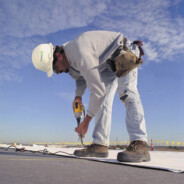Energy
GenFlex helps clear the air on VOCs
“Green” means many things to many people. For building owners, it typically refers to the energy efficiency of a building. For general contractors, it can indicate the sustainability of products and practices. For architects, it sometimes represents the impact of construction on the surrounding ecosystem. And for roofers, we often think of “green” as the amount of Volatile Organic Compounds (VOCs) in the products we use. It’s estimated that more than 80,000 chemicals are commonly used in construction around the world, and there’s a growing backlash against potentially toxic additives like VOCs – a class of chemicals whose emissions can exacerbate respiratory illnesses like asthma. If you’re a construction...
read moreKeep cool this summer with GenFlex’s TPO roofing system
It’s no secret that a building’s energy efficiency and performance are greatly affected by the materials that are used to construct the building. It’s also no secret that selecting the best roofing system for your building can have a significant impact on the building’s cooling costs. Reflective roofing materials protect a building from extreme heat in the summer and reduce surface temperature on the roof by as much as 30 percent, according to Facility Maintenance Decisions magazine. Studies have indicated that reflective surfaces will cool the building in the summer, decreasing the use of air conditioning and, in turn, decrease cooling costs. In fact, in certain geographic regions, the GenFlex TPO cool roof system...
read moreBuilding codes continuously improving energy efficiency standards
The trend of increasing commercial building energy efficiency is not going away anytime soon. More regulations and building codes are setting new standards for new construction projects. Energy efficiency is important to a building’s long-term maintenance and operating costs, making it extremely important to building owners and facility managers. In 2014, the Polyisocyanurate Insulation Manufacturers Association (PIMA) increased the Long Term Thermal Resistance (LTTR) values of polyiso roof insulation. Changes became a priority after more advanced testing methods were adopted that better predicted thermal performance over time. The changes to LTTR values came about in order to provide a comprehensive approach resulting in...
read moreLEED v4 change pushed out until 2016
The United States Green Building Council (USGBC) has decided to extend the usage of the LEED 2009 rating system until October 31, 2016. Originally, the shift to LEED v4 was set to take place in June 2014 and then extended to 2015, but now LEED 2009 registration will continue on until the second half of 2016. This extension will allow users more time to prepare for the changes that are bound to come with LEED v4. At the latest Greenbuild conference, a survey indicated that over 60% of recipients are not sure they are ready to pursue LEED v4 certification, according to a Buildings article. Many recipients also felt that more time for preparation would be needed in order to pursue the new certification. The long-term goal of the...
read moreOctober is energy action month
The U.S. Department of Energy has named October Energy Action Month, asking federal agencies to highlight efforts to save energy throughout government, while encouraging the public to do the same. At GenFlex, we like to think of every month as an energy action month – our roofing products contribute to more energy-efficient schools, offices, factories and more. For example, GenFlex polyiso insulation boards deliver a higher R-value per inch than most comparative roofing insulations; HD ISO board, with an R-value of 2.5, provides better thermal performance than any ½” wood fiber, glass-faced ISO, or glass mat-faced gypsum boards to keep energy from leaking through the roof deck and into the atmosphere. GenFlex also offers...
read morePlanning for harsh weather: Part 2
In our last blog post, we lamented the fact that meteorologists are predicting an early return to winter weather across large portions of the country. That means another tough season for wear-and-tear on commercial buildings – and an opportunity for roofing professionals to help facility managers plan ahead now. A close-up inspection of the roof can keep today’s small punctures, damaged flashings or torn seams from turning into tomorrow’s growing leaks, rising energy bills or spreading mold. Professional roofing contractors are intimately familiar with system specifications, installation, and how a finished system should look and perform. But even the most seasoned technician may not catch every potential problem. A...
read moreIt’s not too early to plan for harsh weather, starting at the top: Part 1
For many of us, last winter is still a recent – and unpleasant – memory. But as we head into fall, it’s already time to start planning for another blast of icy reality across much of the country. Forecasters are predicting another visit from the dreaded ‘Polar Vortex’ across the Midwest and Northeast as soon as September, and the Rockies could also be in line for earlier-than-usual snowfalls. And even though the South may avoid surprise snowfalls, there’s a better-than-average chance of an El Nino system soaking the region with rain and storms that cause their own issues. In short, summer’s over for commercial building owners and facility managers. Planning for harsh weather starts now, starting at the top: The...
read more






